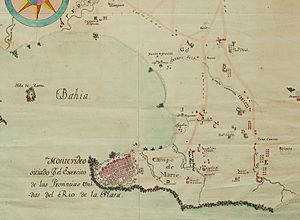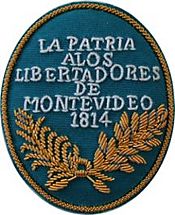Siege of Montevideo (1812–1814) facts for kids
Quick facts for kids Siege of Montevideo (1812–1814) |
|||||||
|---|---|---|---|---|---|---|---|
| Part of the Second Banda Oriental campaign | |||||||
 Map of Montevideo with besieging lines, 1813. |
|||||||
|
|||||||
| Belligerents | |||||||
| Commanders and leaders | |||||||
|
|
||||||
| Strength | |||||||
| 4,000 | 7,000 | ||||||
The Second Siege of Montevideo was a big event that happened between 1812 and 1814. During this time, soldiers who wanted independence, called patriotic troops, surrounded the city of Montevideo. The city was still controlled by people loyal to Spain, led by Gaspar de Vigodet, who was the governor. This siege was a success for the independence fighters. It marked the end of Spain's control in what is now Uruguay.
Contents
What Was the Siege About?
A siege happens when an army surrounds a city or fort. They try to stop anyone or anything from getting in or out. This forces the people inside to give up because they run out of food and supplies. Montevideo was a very important city for Spain in South America. The people fighting for independence wanted to take it over.
How the Siege Unfolded
Montevideo was a port city, meaning it was on the coast. This helped the Spanish because they could get supplies by sea. Even though the city was surrounded by land, ships could still bring in food and other things. This made the siege last a long time, just like an earlier attempt in 1811 that didn't work.
The situation changed in May 1814. A brave admiral named William Brown led the patriotic navy. His ships won important battles at sea. These victories meant that Spanish ships could no longer reach Montevideo. The city's supply route was completely cut off.
The City's Surrender
With no supplies coming in, the people in Montevideo started to run out of food. They faced starvation. By the end of June, Governor Vigodet had no choice. He was forced to surrender Montevideo to General Carlos María de Alvear, who was leading the independence forces. This victory was a huge step for the independence movement in South America.
See also
 In Spanish: Sitio de Montevideo (1812-1814) para niños
In Spanish: Sitio de Montevideo (1812-1814) para niños
- Battle of Cerrito
- Dissolution of the Viceroyalty of the Río de la Plata
- Gaspar de Vigodet
- José Rondeau


